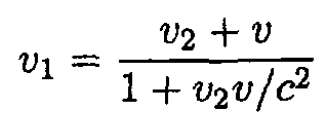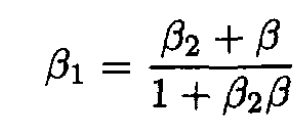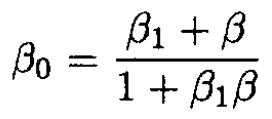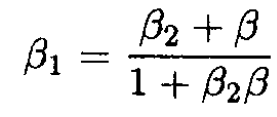
Rapidity
 المؤلف:
Sidney B. Cahn And Boris E. Nadgorny
المؤلف:
Sidney B. Cahn And Boris E. Nadgorny
 المصدر:
A GUIDE TO PHYSICS PROBLEMS
المصدر:
A GUIDE TO PHYSICS PROBLEMS
 الجزء والصفحة:
part 1 , p 36
الجزء والصفحة:
part 1 , p 36
 13-7-2016
13-7-2016
 1612
1612
Rapidity
a) Consider two successive Lorentz transformations of the three frames of reference K0, K1, K2. K1 moves parallel to the x axis of K0 with velocity v, as does K2 with respect to K1. Given an object moving in the x direction with velocity v2 in K2 derive the formula for the transformation of its velocity from K2 to K0.
b) Now consider n+1 frames moving with the same velocity v relative to one another (see Figure 1.1). Derive the formula for a Lorentz transformation from Kn to K0 if the velocity of the object in Kn is also v.

Figure 1.1
Hint: You may want to use the definition of rapidity or velocity parameter, tanh ψ = β, where β = v/c.
SOLUTION
a) The velocity of the particle moving in frame K1 with velocity v2 in the frame K1 is given by a standard formula:

Introducing βi = vi/c we may rewrite this formula in the form
 (1)
(1)
Now the same formula may be written for a transformation from K1 to K0:
 (2)
(2)
Now substituting (1) into (2), we obtain

b) If we need to make a transformation for n-frames, it is difficult to obtain a formula using the approach in (a). Instead, we use the idea of rapidity, ѱ. Indeed for one frame, we had in (1)

which is the formula for the tanh of a sum of arguments

where tanh ѱi = βi. This means that the consecutive Lorentz transformations are equivalent to adding rapidities. So the velocity in the frame K0 after n transformations (if vn+1 = v ) will be given by

We can check that if n → ∞, then βi → 1.
 الاكثر قراءة في مواضيع اخرى
الاكثر قراءة في مواضيع اخرى
 اخر الاخبار
اخر الاخبار
اخبار العتبة العباسية المقدسة


